

Organ "Dom Bedos de Celles" : 5 keyboards, pedalboard - 45 stops
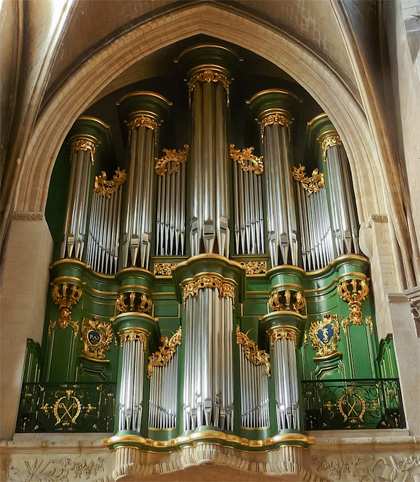
This organ was buit in the middle of the 18th century by "Dom Bedos de Celles", author of the famous treaty published in 1766:
" THE ART OF the ORGAN BUILDER ".
It is, at the same time, the most important instrument built by the illustrious organ builder and the only one that had still enough elements to allow the reconstitution of the original organ.
Indeed, in spite of multiple transformations and damages, it still exists:
- the cases
- The main windchests
- 60 % of the ancient pipes.
The case was cleaned of the brown paint which recovered it and found its color of origin
Composition :
| Positif | Grand-Orgue | Bombarde | Récit | Echo | Pédale |
| 51 notes : C1 à D5 | 51 notes : C1 à D5 | 50 notes : C1 à D5 | 32 notes : G2 à D5 | 39 notes : C2 à D5 | * 32 notes : A0 à E5 |
| ** 36 notes : F0 à E5 | |||||
| Montre 8' | Bourdon 32' | Bombarde 16' | Cornet V rgs | Cornet V rgs | Flûte 16' * |
| Bourdon 8' | Montre 16' | Gros Cromorne 8' | Trompette 8' | Flûte 8' (bois)* | |
| Prestant 4' | Bourdon 16' | Flûte 8' (étain)* | |||
| Doublette 2' | Montre 8' | Tremblant doux | Flûte 4' * | ||
| Petit Plein-Jeu IX rgs | Second 8' | Tremblant fort | Bombarde 16' ** | ||
| Flûte 4' | Bourdon 8' | 1ère Trompette 8' ** | |||
| Nazard 2 2/3' | Prestant 4' | 2ème Trompette 8' ** | |||
| Tierce 1 3/5 | Doublette 2' | Clairon 4' ** | |||
| Larigot 1 1/3' | Grosse Fourniture II rgs | ||||
| Cornet V rgs | Grand Plein-Jeu XIII rgs | ||||
| Trompette 5' | Gros Nazard 5 1/3' | ||||
| Clairon 4' | Grosse Tierce 3 1/5' | ||||
| Cromorne 8' | Nazard 2 2/3' | ||||
| Voix Humaine 8' | Tierce 1 3/5' | ||||
| Grand Cornet V rgs | |||||
| 1ère Trompette 8' | |||||
| 2ème Trompette 8' | |||||
| Clairon 4' |
Couplers : I/II IAppel G.O
Pedalboards : I Appel d'anches I II III et Pedal

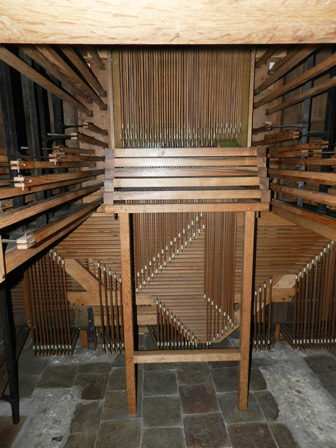
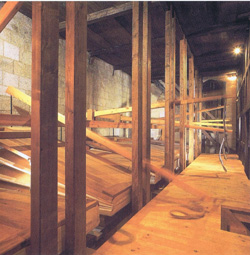
enregistrements audios :
André Raison -Francis Chapelet
Improvisation -Paul Goussot
Dom Bedos, theorist or organ builder ?,
Communication by Pascal Quoirin, organ builder, within the cycle of conferences organized by the faculty of Bordeaux on the occasion of the tercentenary of the birth of Dom-Bedos on Mars 2009
It has been said many things on Dom-Bedos de Celles, by historians, experts but rather rarely by organ builders. That is why I thank the organizers for handing over during the days dedicated to this great man, on the occasion of the tercentenary of its birth.
There is an aspect which always made me a little bit perplexed. It is because, in spite of all the studies made on this craftsman monk, the idea that he was above all an expert or a former organ builder " having given up his trying-plane " to resume the expression of M. Roland Galtier, expert for "Historical Monuments" which made you right here a presentation on this subject, is a still spread idea.
One refers, to support this thesis, to some knowledge which we have on his various travels and some rare documents which tell us his life and action. And it seems to be enough for some people, who never make a reference to what is written in his treaty of almost 800 pages..., to talk at length about the fact that he was only a theorist, that his treaty contains too many errors, in brief, that Dom Bedos was not an organ builder!
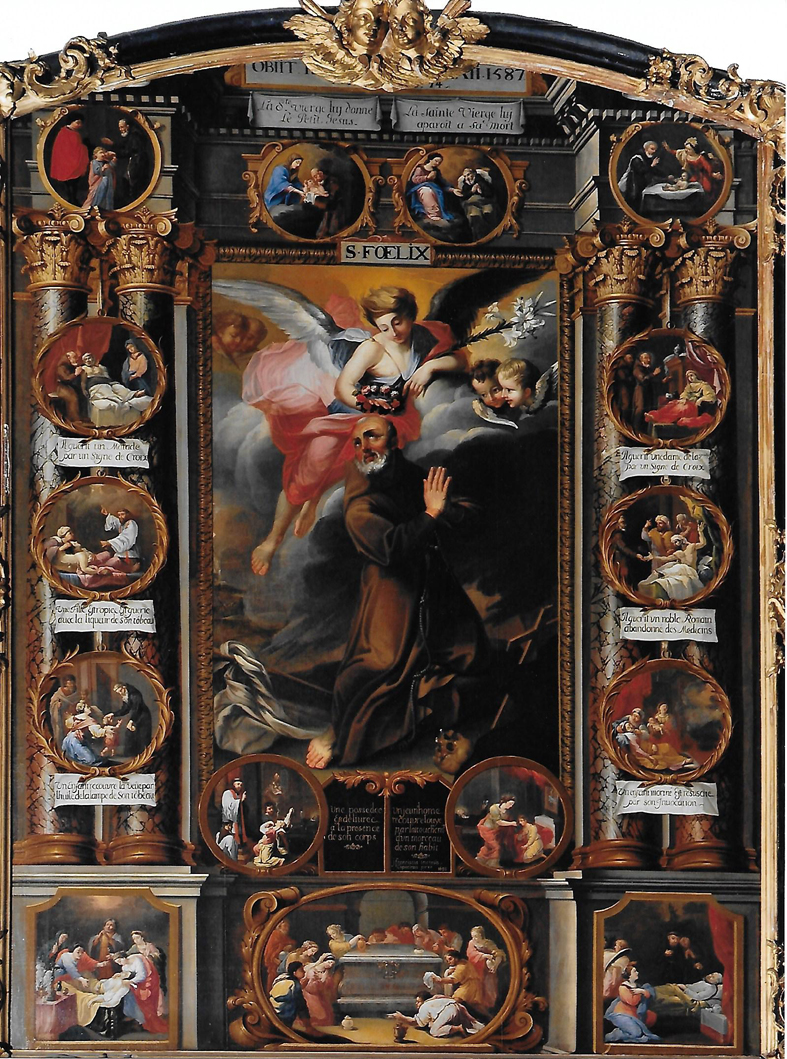 I assure it to you, I have often heard these words, and several times tried to enter this kind of debate, to finally find that the people the most critical had very likely not read a single line of his treaty.
I assure it to you, I have often heard these words, and several times tried to enter this kind of debate, to finally find that the people the most critical had very likely not read a single line of his treaty.
But nevertheless, the most important part of its work is aimed mainly at the apprentice, in the noblest sense of this term. There are, of course, generalities expressed for the architects, and advices given to the organists etc., but all this, always from the same point of view, that of the organ builder that he never stopped being.
The Curricula of Dom Bedos seems clear to me . If he was excellent in his job, it seems to me completely natural that he dedicated a big part of his activity to transmit his knowledge. It's the same even today in all the trades: if you are competent, you will be more and more requested. So you will have to transmit your knowledge and, actually, you will eventually train the others. "To give up the trying-plan" about Dom-Bedos is a regrettable formulation, I see there even a little contempt: the organ builder reduces to his trying-plane, the butcher to his knife, the mason to his trowel …
The treaty of organ building is thus the work of an organ builder, however unpleasant it might seem to Mr. Galtier. We could endlessly make you the demonstration. Every chapter, every line, describes how an organ builder works every day, while recording the good gestures which he has to make, gestures that he made himself obviously, it is indisputable. He warns even errors which he committed himself, as those for example that we were able to notice by restoring the windchests of the organ of Sainte-Croix. Everything is approached with a systematic accuracy while describing several methods. And if the tone is rather kind, its own preferences, on the other hand, are expressed without ambiguity.
What I tell you today, we lived it when we restored the organ of Sainte-Croix. It is very obvious that his treaty structured all our approach but, nevertheless, it was not sufficient. Its consultation was necessary but not sufficient. The reason is simple there: Dom-Bedos does not express unchanging rules for the construction of organs, he gives the organ builder a free hand, while expressing what it will be advisable to do, often mentioning what not to do and also indicating how work the good organbuilders.
This is why the term of "reconstruction", about the works which we made in Sainte-Croix seems to me more appropriate that the term of "restoration". This term could apply, on the other hand, to the works made on the sound equipment, 70 % of which was the original pipework.
The treaty of Dom-Bedos describes an ideal organ, perfectly proportionned in the architectural site, which is not the case in Sainte-Croix: the narrowness of the gallery and its important gap with regard to the axis of the nave, strongly complicated the setting-up of the instrument. If we follow strictly his recommendations, the available space only authorize the setting-up of a "16 feet ordinary" in front.
Most probably, Dom-Bedos saw big, maybe too big, and the constraints which ensued from it, obliged him to imagine some perfectly adapted solutions making of this organ an unique intrument, strictly organized, which leaves no room to improvisation.
Here is how and why, today, it is possible to me to assert it to you, while we knew practically nothing, before beginning this important work of reconstruction, about the way he had conceived his instrument.
In any case, his treaty practically never makes a reference to this organ, except in a extremely discreet and indirect way.
We notice however, a beautiful concordance between the recommendations expressed in his treaty and the equipment got back from the Cathedral St-André. On the other hand, the fact that the same equipment was contained in the cases still on their place in the church Sainte-Croix, seemed to us much less obvious and obliged to us to leave some of its recommendations. It is at this moment that it is necessary "to decode" some passages of the treaty. I take the example concerning the sequencing of the windchest's ruler, Dom Bedos says this: " we shall not burden ourselves, as do certain organ builder (in this particular case, he speaks of himself), to follow the organization of the facade to make the windchest's ruler, it is a source of important misstakes etc. …
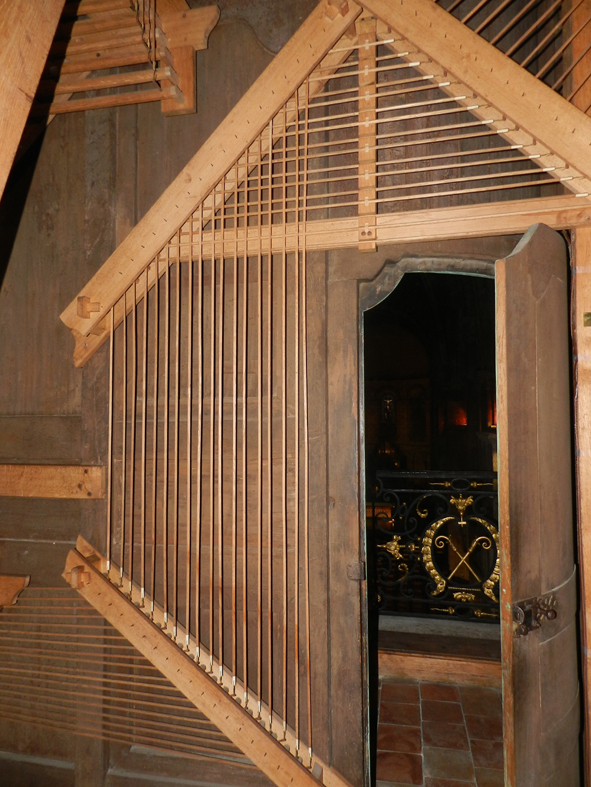
As regards the organ of Sainte-Croix, this rule is not absolutely applied. The windchest's ruler really takes into account the facades' organization, as well for the positive as for the Great-Organ. If we had applied literally what Dom-Bedos writes on this precise point, we would very quickly have found ourselves in a dead end. It is one of the first observations that we made during the study of reconstruction of this organ and it is the starting point of all the continuation of the program. Indeed, even if we had been able to get back the original windchests (4 of the big organ, 3 of the positive, 2 of the pedal), nothing indicated us their constituent rulers. These windchests which had suffered profound mutilations, had been partially plugged to create a ruler different from that of origin.
It was thus necessary to refind this ruler definitely, because it is from the ruler that is going to ensue all the organization of the instrumental part and all the internal arrangement of the sound equipment.
The indication was given to us by the notation of a complete series of pipes: Nasard of the Great-Organ. This one, noted in diverse manners, presented among all, a logical series of marks, in an ancient written form, in any case the oldest, thus, most probably, by the hand of Dom-Bedos.
From then on, the reconstruction of all the organ became possible and as we moved forward, this beautiful arrangement, imposed on all the organ a relentless logic.
This being put, the problems connected to the narrowness of the site or to the excessive size of the project still remained.
We are often confonted to a general problem of "positioning": positioning of the sound equipment essentially, in a way that he can work naturally without being "offended" (It is the term appropriate to Dom-Bedos). The fact of having planned a Bourdon of 32 feet imposes a sound scale equal to that of a very big organ with a significant number of wooden pipes to be placed in the great case (a total of 87 pipes: 3 octaves of 32 foot Bourdon, 2 octaves of 16 foot Bourdon, 2 basses of 8 feet among which A °).
From the establishment of the windchest's ruler , Dom-Bedos had inevitably already in mind the organization of the positioning of all this equipment, as if he had made a complete plan of the instrument before beginning it. This leaves me a little bit perplexed, given that Dom-Bedos, who recommends to plan everything so that the organ is, as he tells it "well heard", does not talk about making plans of the organ as we do nowadays. This way we have today to make numerous plans would rather come from Cavaillé-Coll. It is more in touch with a need to work effectively, to distribute the tasks rationally, in a way that the activity is economically viable.
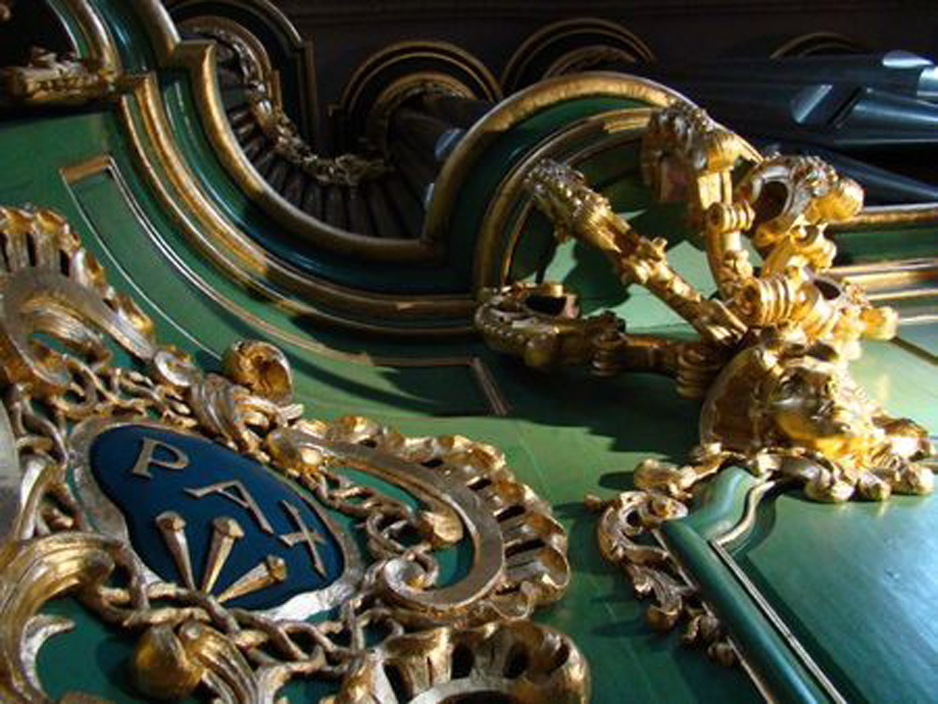 The example the most striking in this surprising arrangement is the position, in the organ, of A° of the 16 foot Bourdon and the A1 of the 32 foot Bourdon, two perfectly identical and bulky pipes (size 300 mm) and big wind consumers. The windchest's ruler mentions both groove channels in the extremities of the both treble windchests, these are situated in the middle of the 12 feet turrets, in the exact location of a skeleton's post of strong section: the place of these 2 pipes is completely natural and the route of wind to feed them does not exceed 20 cm.
The example the most striking in this surprising arrangement is the position, in the organ, of A° of the 16 foot Bourdon and the A1 of the 32 foot Bourdon, two perfectly identical and bulky pipes (size 300 mm) and big wind consumers. The windchest's ruler mentions both groove channels in the extremities of the both treble windchests, these are situated in the middle of the 12 feet turrets, in the exact location of a skeleton's post of strong section: the place of these 2 pipes is completely natural and the route of wind to feed them does not exceed 20 cm.
Here is an example of the beautiful disposition, perfectly logical, that is present in all the instrument and which makes it a unique specimen of the organ building.
Dom-Bedos insists on the fact of planning everything well.
In its work, this approach is paradoxically described rather according to the progress of the construction process.
More exactly, for example, as regards the chapter which is entitled " Way of placing the various pipes which... ", he gives obviously the best advices on this matter but, this chapter begins so: " The windchestsb being in position in the organ... " is not it a little late?
It is actually what we notice in certain organs where the position of the pipes, which are not "on their wind", seems to have been realized before having be thought.
But, after all, if we do not have any plan of organs of this time, we have to admit that there was no plan, at least under the present form. This one rather arises from the industrial era. Moreover, today, in secondary schools, we often indicate this discipline under the expression: "technical drawing".
When the instrumental parts of the organ of Wenner, which had occupied for a moment the cases of Dom-Bedos, were taken off, we discovered a layout on the gallery's floor. This layout represented, viewed from above, the arrangement of the three positive's windchests and a central axis. The rest of the surface of the gallery contained no other plan, because the stone floor would most probably have been changed at this location.
The sizes measured on this layout of the positive's windchests corresponded well to the still existing windchests. There had been thus well a plan or rather a layout of the windchests made previously.
For the reconstruction of the Positive, things were simple, the position of the windchests was given by the layout on the ground and everything went naturally, the windchests thus found themselves in perfect adequacy with the facade.
For the Great-Organ, there was no layout on the ground so it is the case which indicated us the exact position of the windchests. The front and the back of the big case are interconnected by some strong section bars of oak. They have a triple role: to support 4 big windchests, to assure the regular space between the front and the back of the organ, and to support the turrets. There is no possible ambiguity on the position of these bars because they are fixed behind the case by key joinings the passages of which, through the cases's back stretchers, were very clearly identified.
We can, once again, notice the relentless logic of the conception peculiar to Dom-Bedos. These elements of skeletons with triple functions really testify of a clear and simple conception, with some moderate cost means. This also reveals the global character of the organ's conception where the drawing of the cases, their proportions, the requirements of the instrumental parts make a whole perfectly accomplished.
All the reconstruction took place then logically and naturally, as regards in particular the elements of the positive's stop action that match very exactly into the axes holes of the metallic rollers remained intact in two pieces of oak, embedded on the gallery floor since 1748.
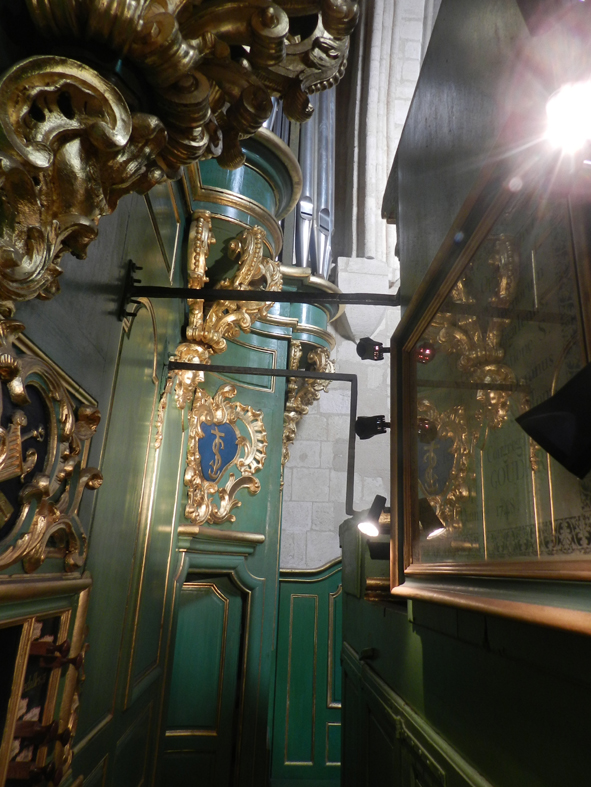 This organ is really the work of an organ builder. It is not the application of a theory on the organ building, like it is sometimes said, because its construction precedes the writing of the treaty. There is not in Dom-Bedos, as Mr. Galtier (expert for the historical monuments) lets it imply, a dichotomy of the character: the one so-called organ builder became an expert, the other former organ builder " having given up its trying-plane ". It is simply an organ builder who writes on his job. It is what gives him this indisputable authority, recognized even today in all the profession, authority which has nothing common with that of the experts of today.
This organ is really the work of an organ builder. It is not the application of a theory on the organ building, like it is sometimes said, because its construction precedes the writing of the treaty. There is not in Dom-Bedos, as Mr. Galtier (expert for the historical monuments) lets it imply, a dichotomy of the character: the one so-called organ builder became an expert, the other former organ builder " having given up its trying-plane ". It is simply an organ builder who writes on his job. It is what gives him this indisputable authority, recognized even today in all the profession, authority which has nothing common with that of the experts of today.
And in this connection, the expertises published by Dom-Bedos also demonstrate his real competence. All that he says can be said only by an organ builder who analyzes what he observes since his own practice of the job, his own experience.
The expertises of Dom-Bedos are severe but fair. Very few organs built today would resist to such an examination, what proves, if it was still necessary to convince, the very high level of practice of our trade in the 18th century.
To end, I would like informing you about the state of preservation of the organ of Sainte-Croix. It concerns essentially the sound equipment. A big part of this one is affected by the tin leprosy. Many unhealthy parts of the metal constituting the whole piping were replaced, on the occasion of our restoration, by pieces of metal of the same titration. Pipes then regained their integrity. They found all their original sound quality.
But the tin leprosy is a phenomenon of oxidation which never stops. We notice even today a slow but certain degradation of a number of pipes which could, in the future, become porous and will thus be unfit any more to play correctly. We repair them regularly but today some are no more repairable. They are in the same state as the facade pipes which we had to redo in copy and which remain stored behind the organ. We suggested, for some time, to redo these pipes in copy according to the need and to keep originals by storing them behind the organ as it is for the original facades. We consider that these interventions would concern about 1 in 2 pipes approximately every 5 years.
When all the piping in two, three or four centuries (or can be less) will have been replaced, shall we always be in front of the organ of Dom-Beods? I shall answer you by another question: are we, when we admire the facade of the Cathedral "Notre-Dame-de-Paris", in front of an authentic work, while so much stones were replaced already?